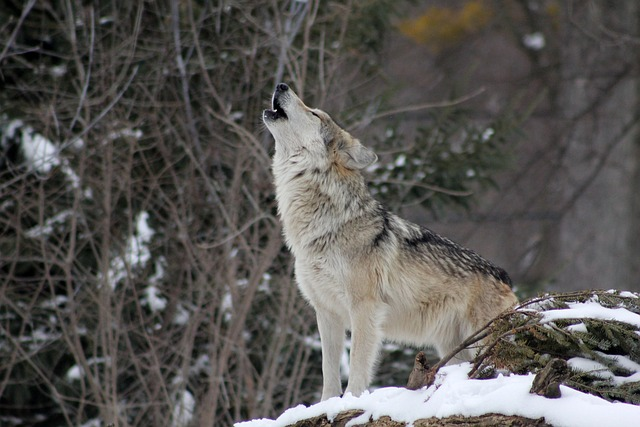Whenever you hear about wolf howling the first thing comes to your mind is wolf howls at the moon.

Wolf howling at the moon is famous, as it is used in many movies and cartoons. But is it a myth or truth?
Wolf howl can be heard 10 miles away. Howling is one of their vocal way of communication. It is low pitch and have long duration, and they uses it for various purposes. Let’s understand in this blog why wolves howl, and how far it can be heard.
Wolves and Howling
Why Do Wolves Howl?
Gray wolves uses howling to proclaim their presence, and their pack’s territory. Further to locate their opponents, and it help lone wolves to find their potential mates.
Additionally wolves do chorus howling to strengthen its social bond with other wolf’s pack. Their low pitch and long duration howling is compatible for transmission on the wild landscape.
How far can a wolf howl be heard?
A wolf howl can be heard 10 miles away in an open terrain. The wolves uses howling mostly in night time as it works efficiently that time. Because there are less other interruption of other sounds that can weakens its strength.
But wolves not only uses howling, there are many other sounds like barking growling and whimpering. They also uses combination of sounds with howling, like howl-growl, and bark-growl.
How far do howls travel?
Wolves, renowned for their haunting vocalizations, that can travel up to 10 miles (16 kilometers) across the wilderness.
This impressive range is made possible by their unique adaptations, including powerful vocal cords and the this remarkable ability enables them to communicate with pack members, mark pack’s territory, and even locate potential mates.
Is it a wolf or a coyote?
Coyotes and wolf both belong to the same canidae family, and both can howl. However there is a notable difference in the coyotes howling. Such as the length and pitch of it.
A coyote’s howl make sharp and high pitched sound with short time period. On the other hand a wolf howl’s low pitch with longer duration.
Do wolves bark?
Yes wolves do bark. As barking is not limited to domestic dogs. It is one of the common type of communication wolf uses.
Moreover, a wolf mother bark at pups to alert them or stop them. They howl bark at other animals to express their aggression to defense of their pack’s territory.
Why do wolves howl at the moon?
Wolves do not bark at the moon, it is just a made up thing. No doubt a moon impacts a wolf, as it does human.
Despite popular belief, the notion of wolves howling at the moon is more of a myth than reality. Wolves howl for various reasons, none of which are directly related to lunar cycles.
These wild animals use their howls as a means of communication within their packs, expressing their location, social bonds, and even warnings to rival packs.
Do wolves howl to mate?
Wolves, renowned for their haunting howls, while howling is often associated with their social communication and territorial claims, it also serves a vital role in their mating rituals.
During the breeding season, which typically occurs in late winter or early spring, wolves utilize their howls to attract potential mates.
These vocalizations act as a melodious love song, signaling their availability and reproductive readiness to other pack members and distant wolves alike.
Do wolves mate for life?
Wolves are monogamous animals, which means they mate with one partner for their entire life. Once a pair bonds, they embark on a remarkable journey together, raising their offspring and guarding their territory as a united front.
How far away can a wolf smell its prey?
Wolves remarkable sense of smell shows their hunting prowess and survival instincts.
Wolf’s sense of smell is approximately 100 times more acute than that of humans, enabling them to detect odors over vast territories.
In favorable conditions, such as in open terrain, a wolf can detect the scent of its prey up to 1.5 miles away.
What sound does a arctic wolf make?
Arctic wolves, also known as white wolves, are a subspecies of the gray wolf and are native to the Arctic regions of North America and Greenland.
These wild creatures are known for their beauty and resilience, and their vocalizations are an important part of their social behavior.
Arctic wolves communicate with each other through a range of sounds, including howls, barks, and growls. Their howls can be heard over long distances, and they use them to communicate with other pack members and to warn off intruders.
Why do coyotes howl together at night?
Coyotes are known for their haunting howls that echo through the night. These can be heard in the distance.
Coyotes are social animals that live in family groups, and they use their howls as a form of communication.
They howl to communicate with other coyotes in their pack and to establish their territory. Additionally, they may howl to call other members of their pack together, especially during hunting or mating seasons.
Conclusion
A wolf’s howl can be heard miles away in open terrain, it is mostly low in pitched, and remains for longer period. Howling is one of the type of vocal communication which wolves uses to communicate with other wolves, and with the wolves of their pack.
They uses howling with other sounds such as bark howl. Each sound has special purpose, for example a mother wolf uses bark howl to show aggression to the pups.
Moreover, not even grey wolves, other species of wolves like coyotes, arctic or white wolves also howls.
Lastly, there is a misconception about wolf’s howling that it howls at moon, which is false as howling is just a way of their communication. For more details you can check out the video below.











































